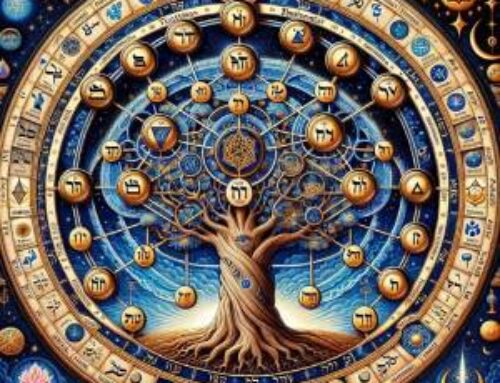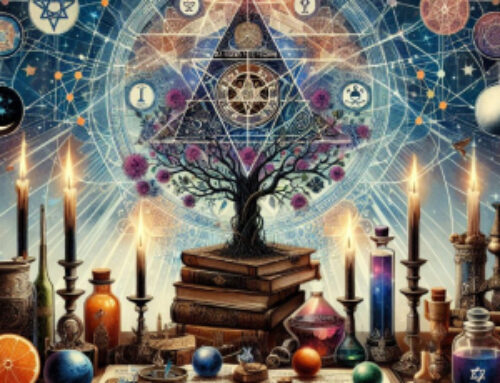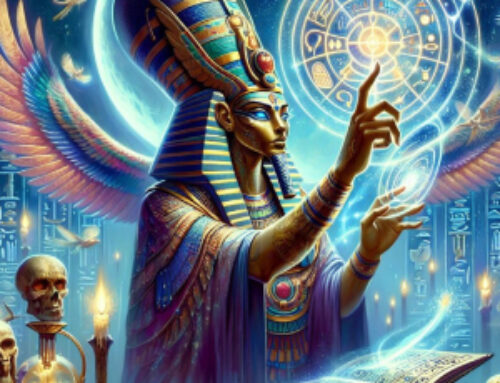Contents
- 1 Introduction: Introduction to Esotericism.
- 2 The Nature of Esoteric Knowledge
- 3 The Role of Meditation and Inner Transformation in Esoteric Traditions
- 4 Navigating the Esoteric Pathways to Celestial Wisdom
- 5 The Esoteric Vision of Creation and Existence
- 6 The Ethical and Moral Dimensions of Esotericism
- 7 Challenges and Misunderstandings of Esotericism
- 8 Conclusion
- 9 FAQ – Introduction to Esotericism
- 10 References
Introduction: Introduction to Esotericism.
An introduction to esotericism can be a gateway to understanding hidden wisdom. This prelude to esotericism beckons you on an enthralling odyssey beyond the mundane’s veil, into the sanctum of mysticism, where the esoteric or “inner” facets of reality are unraveled. Esotericism stands not simply as an aggregation of arcane practices and theoretical cognizance; it is a conduit to profound spiritual revelation and comprehension, proffering insights that eclipse conventional apprehensions of reality.

At its essence, esotericism represents the search for a deeper, directly experiential apprehension of the divine, the mystical, and the metaphysical. It encompasses an expansive compendium of traditions, including, but not confined to, Kabbalah, Hermeticism, Gnosticism, and Sufism, each distinguished by its unique symbols, rituals, and doctrines, devised to steer the seeker towards inner illumination and metamorphosis. This quest challenges the seeker to peer beyond material existence, to decrypt the symbols and allegories that have encased wisdom for eons, and to partake in rituals that purify the spirit and augment consciousness.
The esoteric pathway is laden with the prospect of revealing the universal verities that coalesce the cosmos, offering the keys to unlock the mysteries of creation, the essence of the divine, and the fate of the human soul. It beckons a reassessment of our position in the universe, advocating for a symphonic balance between the external realm of form and the internal realm of essence. As we initiate this introductory voyage into esotericism, let us unfurl our minds and spirits to the boundless potentials that lie in wait, prepared to illuminate the concealed depths of existence and our authentic selves.
The Nature of Esoteric Knowledge
Esotericism represents the study and practice of hidden knowledge, focusing on the quest for understanding the spiritual truths underpinning the cosmos. This realm of knowledge diverges significantly from the empirical methodologies that dominate the modern quest for understanding, embracing instead a journey inward towards spiritual awakening and enlightenment. It is an exploration that goes beyond the tangible and observable, delving into the mysteries that lie at the very heart of existence and consciousness. After an introduction to esotericism, many find themselves drawn to deeper study.
The Path to Inner Wisdom
Central to esotericism is the concept of personal transformation—a spiritual alchemy where the seeker’s baser instincts and qualities are transmuted into a higher state of awareness and being. This transformative journey is highly individualistic, involving practices such as meditation, contemplation, and adherence to specific spiritual disciplines that, although varying across different esoteric traditions, all aim towards the same pinnacle of spiritual attainment. The seeker is both the pilgrim and the path, navigating through layers of inner reality to realize the true essence of self and universe.
The Role of Symbols and Allegory
Esoteric teachings are rich in symbolism, allegories, and parables, serving as keys to unlocking profound spiritual truths. These symbols are not mere artistic expressions but are imbued with deep meanings that transcend literal interpretation. They act as vessels for esoteric wisdom, offering insights into the nature of reality, the cosmos, and the soul’s journey through the spiritual dimensions. Through the study and contemplation of these symbols, the seeker is guided deeper into the mysteries of esoteric knowledge, each symbol acting as a beacon on the path to enlightenment.
Esotericism and the Quest for Universal Truths
At its heart, esotericism is a quest for universal truths—a search for the underlying unity that binds all of existence. It posits that beyond the myriad forms and phenomena of the visible world lies a singular, unifying principle that can be comprehended only through the inward journey of spiritual awakening. This pursuit is not for the acquisition of theoretical knowledge but for a direct, experiential understanding of the divine nature of reality. It is a path marked not by the accumulation of facts but by the realization of one’s unity with the all-encompassing cosmic order.
The Role of Meditation and Inner Transformation in Esoteric Traditions
In the heart of esoteric traditions lies a profound emphasis on meditation and inner transformation as essential practices for spiritual growth and enlightenment. These practices are not mere exercises in relaxation or concentration but are deeply transformative processes that seek to refine the individual’s inner landscape, awakening latent spiritual faculties and aligning the soul with the universal truths.
Meditation: A Gateway to the Inner Self
Meditation serves as a foundational practice within esotericism, acting as a direct pathway to the deeper aspects of the self and the cosmos. Through various forms of meditation, practitioners embark on an inward journey, transcending the limitations of the physical senses and the chatter of the mind to experience states of profound stillness and unity with the divine. This practice is key to unlocking the inner senses, facilitating a direct perception of spiritual realities that remain hidden from ordinary consciousness.
Inner Transformation: The Alchemy of the Soul
The ultimate goal of esoteric practices is not the accumulation of esoteric knowledge for its own sake but the profound transformation of the practitioner. This inner alchemy involves the purification of the lower self—characterized by egoic desires, attachments, and illusions—and the cultivation of the higher self, embodying virtues such as compassion, wisdom, and unconditional love. Through disciplined practice, the individual undergoes a metamorphosis, emerging as a more spiritually attuned being, capable of perceiving and manifesting the divine will.
Developing the Inner Senses
Esoteric traditions teach that beyond our physical senses lies a set of subtle, inner senses that enable direct spiritual perception and knowledge. Meditation and inner transformation work together to develop these senses, allowing the practitioner to perceive the subtle energies, spiritual beings, and hidden dimensions that interpenetrate the physical world. This enhanced perception is crucial for navigating the spiritual path and for understanding the interconnectedness of all life.
The Integration of Practice and Daily Life
The pursuit of meditation and inner transformation extends beyond formal practice sessions into every aspect of daily life. Esotericism advocates for a holistic approach to spiritual development, wherein every action, thought, and interaction is imbued with mindfulness and the intention for spiritual growth. This continuous inner work fosters a state of living meditation, where the practitioner remains connected to spiritual realities and guided by higher wisdom throughout the day.
Challenges and Rewards of the Esoteric Path
Embarking on the path of meditation and inner transformation is not without its challenges. It requires perseverance, discipline, and a willingness to confront and transcend one’s limitations. However, the rewards of this spiritual journey are immeasurable. Practitioners gain not only a deeper understanding of themselves and the universe but also experience profound peace, joy, and a sense of unity with all of existence. Through the dedicated practice of meditation and the ongoing work of inner transformation, the esoteric seeker becomes a beacon of light, contributing to the spiritual awakening and evolution of humanity.
Kabbalah stands as a beacon within the labyrinth of esoteric wisdom, an ancient tradition whose roots intertwine with the foundational myths of numerous spiritual doctrines across the globe. This mystical avenue offers more than a mere schematic of cosmic creation and operation; it beckons on a profoundly personal odyssey towards spiritual awakening. Through Kabbalah, the seeker is drawn into a tapestry of concealed correspondences, initiatory rites, and the quest for divine gnosis, all converging to unveil the enigmas of the cosmos and the soul’s domicile within. This introduction to esotericism will further highlight the importance of inner knowledge.
Initiation: The Gateway to Mysticism
The passage into Kabbalah is heralded by initiation, a sacrosanct rite embodying the aspirant’s vow to the esoteric voyage. This ceremonial threshold signifies the commencement of a transformative expedition, heralding the seeker’s preparedness to delve into the profound realms of consciousness and spiritual verities. It is through this initiatory gateway that one is symbolically reborn into a realm wherein esoteric wisdom is unveiled, charting the course for profound personal and spiritual evolution.
Deciphering Hidden Correspondences
At the core of Kabbalistic pursuit thrives the exploration of concealed correspondences, especially those delineated by the Tree of Life. This emblematic atlas delineates the structure of being, tracing the divine emanation from the ineffable origin through myriad manifestations. Each sephira (node) on the Tree epitomizes an aspect of the divine cascade into the material plane, granting the seeker insights into the essence of the Divine, the cosmos, and the human spirit. Through contemplation and erudition, Kabbalists strive to comprehend these celestial principles and their interconnection, aspiring towards a holistic understanding of the universe and their place within it.
The Esoteric Vision of Creation and Existence
Esoteric doctrines proffer a profound, often revolutionary perspective on creation, reality, and divinity, diverging significantly from exoteric or orthodox religious interpretations. These insights advocate for a deeper, emblematic comprehension of existence and the creative process, perceiving the material realm as a manifestation of divine axioms, not as mere physical happenstance or chaos.
Creation: A Mirror of Divine Intent
Within the esoteric framework, creation is no fortuitous event but a purposeful manifestation of divine volition, transitioning the cosmos from the formless to form. This sacred act is eloquently encapsulated within the Kabbalistic paradigm, which envisages creation as the diffusion of divine luminescence through the sephirot of the Tree of Life. Each sephira embodies a distinct facet of God’s creative potency, illustrating the transition of the Infinite into the manifest world.
The Divine Essence and the Act of Creation
Esoteric traditions often portray the Divine not as an anthropomorphic entity but as the boundless, unfathomable wellspring of all existence. In Kabbalah, the nature of the Divine is articulated through the notion of Ein Sof (the Infinite), signifying a divine essence that transcends human grasp. The creative act is envisaged as a divine effusion, where the essence of God becomes progressively densified through various gradations, culminating in the tangible universe. This perspective reveals a tiered reality, wherein the material world emerges as the final emanation from the divine source.
Humanity’s Position within the Cosmic Fabric
Esoteric teachings posit that humanity occupies a pivotal role within the cosmic schema, acting as a conduit between the material and ethereal realms. Humans are envisioned as microcosms of the cosmos, embodying the same divine ordinances that govern the celestial order. This understanding bestows a hallowed duty upon humanity, underscoring the imperative of spiritual ascension and the realization of one’s divine essence. Through disciplines such as meditation, ceremonial practice, and the study of holy geometries, individuals can awaken to their innate divinity and contribute to the universal harmony.
The Ethical and Moral Dimensions of Esotericism
Esoteric traditions place significant emphasis on ethical teachings and moral considerations, framing them as indispensable to the pursuit and application of hidden knowledge. This emphasis underlines the belief that spiritual maturity and ethical development are prerequisites for engaging with esoteric wisdom. Within these traditions, the acquisition and use of esoteric knowledge come with profound responsibilities, highlighting the transformative impact of such wisdom on the practitioner and the broader world.
Ethical Purification and Spiritual Responsibility
Esoteric paths, including Kabbalah, stress the importance of ethical purification and the careful stewardship of spiritual practices. For instance, the awakening of Kundalini energy, a concept explored in Kabbalistic teachings, is treated with great reverence and caution. This powerful energy associated with profound spiritual and sometimes physical effects, necessitates a disciplined approach rooted in ethical purity and gradual training. The potential dangers of careless experimentation underscore the responsibility that comes with esoteric practice, urging a respectful and conscientious engagement with spiritual forces.
Moral Teachings and the Role of Humanity
Esotericism also delves into the moral obligations of individuals within the cosmic order, advocating for a life of service and devotion as a reflection of spiritual understanding. The notion of serving freely, without the shadows of separation, and the concept of love as a driving force for perfection and peace, illustrate the ethical landscape that esoteric practitioners navigate. This perspective is not merely philosophical but practical, guiding actions, interactions, and the personal journey of transformation towards embodying divine qualities in everyday life.
Consequences and the Call to Ethical Living
The teachings caution against the misuse of occult symbols and esoteric knowledge for selfish ends, emphasizing the karmic repercussions of such actions. The historical misuse of esotericism, highlighted by events such as the Second World War, serves as a stark warning about the consequences of irresponsibility and ego-driven misuse of power. The ethical dimension of esotericism thus extends beyond personal spiritual development to encompass a broader responsibility towards humanity and the natural world, advocating for a harmonious existence that respects the sanctity of life and the integrity of spiritual practice.
Challenges and Misunderstandings of Esotericism
Esoteric studies face significant challenges and misunderstandings, often stemming from misconceptions about the nature and purpose of esoteric knowledge. One major challenge is the confusion between genuine spiritual growth and the mere acquisition of occult knowledge or powers. This distinction is crucial, as true esoteric teachings focus on the transformation and evolution of the soul, rather than simply gathering esoteric information or developing psychic abilities.
The Risk of Pseudo-Esotericism
In contemporary culture, there’s a proliferation of pseudo-esoteric teachings that dilute or misrepresent the true essence of esoteric traditions. These can range from commercialized versions of ancient wisdom to superficial teachings that promise quick spiritual enlightenment without the necessary work. Such distortions can lead seekers astray, emphasizing the importance of discernment in the spiritual journey.
The Misuse of Esoteric Symbols
A profound challenge within esotericism is the potential for the misuse of powerful symbols and practices. Historical examples, such as the misuse of occult symbols by the Nazis, illustrate the dangers of wielding esoteric knowledge without wisdom or ethical grounding. This underscores the responsibility that comes with accessing esoteric wisdom and the importance of ethical maturity among practitioners.
Distinguishing True Esoteric Teachings
True esoteric teachings are marked by a deep commitment to spiritual growth, ethical integrity, and the pursuit of wisdom that transcends the personal ego. They require a disciplined approach to study and practice, often involving a path of initiation that gradually unfolds the deeper mysteries of existence. Authentic esotericism is far removed from the populist, so-called esoteric spirit of the times, and remains a secret doctrine, accessible only through a genuine initiatory path, such as that offered by the Hermetic Academy.
Conclusion
The exploration of esotericism invites us into a realm where the pursuit of hidden knowledge opens doors to profound spiritual insights and transformative experiences. This journey, as we have discovered, is not merely about acquiring obscure facts or delving into the mystical for its own sake. Rather, it is a deep dive into the heart of existence, seeking to understand the intricate dance of the cosmos and our place within it as conscious beings.
Esoteric traditions, with their rich tapestries of symbols, rituals, and teachings, offer pathways to understanding that go beyond the material and into the very essence of the divine. They challenge us to look within, to refine our inner being through meditation and inner transformation, and to approach the divine mysteries with a sense of humility and reverence.
The path of esoteric wisdom is marked by the ethical and moral growth it demands from its seekers. It teaches that true spiritual power and insight are not ends in themselves but are to be wielded with responsibility and for the higher good. This journey is fraught with challenges, including the risk of misunderstanding and the allure of pseudo-esotericism, yet it remains a vital and enriching path for those who are called to it.
As we conclude this introduction to esotericism, may we carry forward the light of understanding and the warmth of spiritual kinship, knowing that the mysteries of the cosmos are not just to be explored but lived. In the words of the ancient wisdom, “As above, so below; as within, so without.” Let this understanding illuminate our paths as we navigate the complexities of existence, drawing ever closer to the profound beauty that lies at the heart of all creation. The introduction to esotericism provided here is just the tip of the iceberg.
Invitation to a Transformative Journey
Are you drawn to the mysteries of the cosmos and the hidden depths of spiritual knowledge? The Hermetic Academy invites you on a transformative journey into the heart of esoteric wisdom. Through our structured courses and guided practices, you will explore the rich tapestry of ancient teachings, from Kabbalah and Hermeticism to the sacred arts of alchemy and theurgy. he Hermetic Academy provides a comprehensive initiatory path, offering keys to unlock the mysteries of existence and tools for personal transformation.
FAQ – Introduction to Esotericism
1. What is esotericism?
A: Esotericism is the exploration and practice of hidden spiritual knowledge and wisdom, focusing on inner, mystical dimensions of spirituality aimed at personal enlightenment and uncovering the mysteries of the universe. It involves symbolic teachings that require spiritual maturity for full understanding.
2. How does esotericism differ from exoteric religious practices?
A: Esotericism is inward and private, emphasizing personal spiritual growth and the attainment of direct experiential knowledge of the divine. In contrast, exoteric religious practices are outward and public, focusing on communal worship and adherence to dogma.
3. Can anyone study esotericism?
A: Not everyone can access esoteric teachings in the same way as exoteric knowledge. Esotericism is intended for those ready and willing to explore its depths, often preserved within mystery schools like the Hermetic Academy.
4. What are some common practices in esoteric traditions?
A: Common practices include meditation, contemplation, ritual, initiation, study of esoteric symbols, and ethical living. These aim to refine consciousness, develop spiritual faculties, and establish a direct connection with the divine or universal principles.
5. What role does the Hermetic Academy play in studying esotericism?
A: The Hermetic Academy provides courses, initiations, and guidance in esotericism, focusing on teachings from various traditions like Kabbalah, Hermeticism, and alchemy. It supports seekers in personal transformation and ethical application of spiritual knowledge.
References
(1) Keegan, L. (1991). Spiritual Journeying. Journal of Holistic Nursing, 9, 14 – 3. https://doi.org/10.1177/089801019100900103.
(2) Tang, Y., Hölzel, B., & Posner, M. (2015). The neuroscience of mindfulness meditation. Nature Reviews Neuroscience, 16, 213-225. https://doi.org/10.1038/nrn3916.
(3) Rubenstein, E. (2023). Alchemy: Secrets of Consciousness Transformation. Hermetic World, Paphos.





